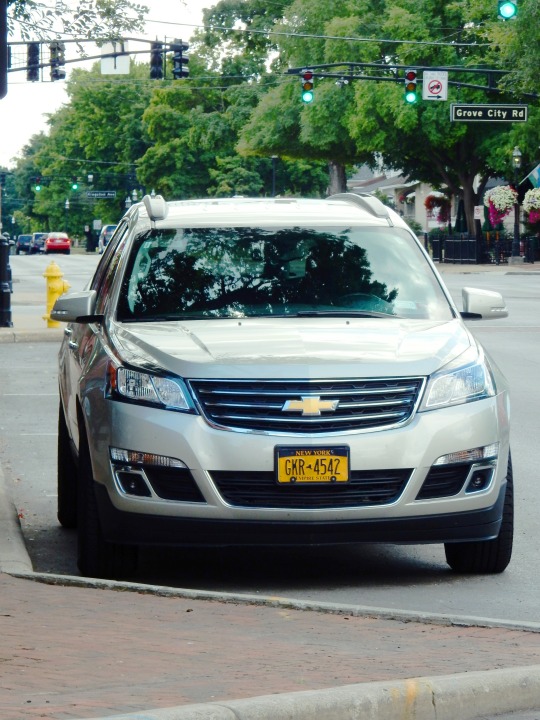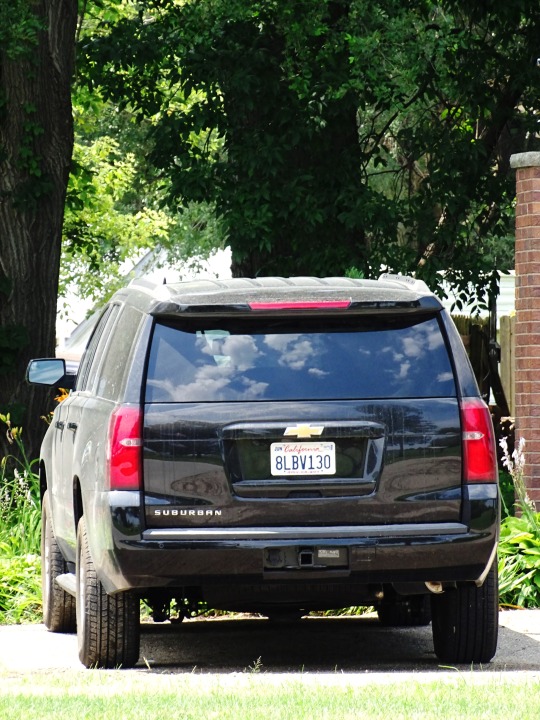#april 20th 1902
Explore tagged Tumblr posts
Text

La Mode illustrée, no. 17, 27 avril 1902, Paris. Robe avec veste-boléro. Modèle de Mlle Louis-Piret, rue Richer, 43. Ville de Paris / Bibliothèque Forney
La jupe de cette robe en voile gris est bordée d'un volant en forme, recouvert de biais d'étoffe, plus haut derrière que devant; on en masque la jonction sous une bande étroite de guipure.
Les contours du boléro, des revers et du col recouverts de biais de voile, sont ornés de guipure ainsi que le bas des manches évasées et les poignets retenant les bouillonnés en soie; on complète la robe par une chemisette en toile de soie rose.
Toquet en taffetas gris drape, garni à gauche d'une plume d'autruche noire fixée sous un chou en taffetas rose.
—
The skirt of this gray voile dress is edged with a shaped flounce, covered with bias tape, higher at the back than at the front; the junction is hidden under a narrow band of guipure.
The edges of the bolero, the lapels, and the collar, covered with bias tape, are adorned with guipure, as are the bottom of the flared sleeves and the cuffs holding the silk cuffs; the dress is completed with a pink silk chemisette.
A draped gray taffeta cap, trimmed on the left with a black ostrich feather attached under a pink taffeta bow.
#La Mode illustrée#20th century#1900s#1902#on this day#April 27#periodical#fashion#fashion plate#cover#color#cover redo#description#Forney#dress#Modèles de chez#Mademoiselle Louis Piret#april cover redos#fav april
38 notes
·
View notes
Text




West Side Market
1979 W 25th St.
Cleveland, OH 44113
The West Side Market is the oldest operating indoor/outdoor market space in Cleveland, Ohio. It is located at the corner of West 25th Street and Lorain Avenue in the Ohio City neighborhood.
The market began operating in 1840, across the street from its current location. Josiah Barber and Richard Lord, prominent businessmen and both former mayors of Ohio City before it was incorporated into Cleveland, donated land to Ohio City's government, stipulating that the tract be used for an open-air neighborhood market. The market space became a center of the Ohio City community for the next three decades and other benefactors donated adjacent lands allowing the marketplace to expand. In 1868, a one-story, wooden framed building was erected on the site, and the newly christened Pearl Street Market was opened.
Thanks to brisk population growth in Cleveland and Ohio City in the latter part of the 19th century, the market outgrew its space again. In 1902, lands were purchased across the street from the Pearl Market site to allow for market expansion and eventual construction of additional indoor market space. Cleveland architectural firm Hubbell and Benes was contracted to create the new indoor space and, after nearly a decade of planning and construction, the current West Side Market building was completed in 1912 at a cost of nearly $680,000. The Neo-Classical/Byzantine building is a brick construct with a large interior concourse that provides nearly 100 stalls for sellers and an 85-stall outdoor produce arcade that wraps around the side and rear of the main building. In addition, the building has a large clock tower, easily visible from most of Ohio City in the building's early days.
In 1915, the permanent building spurred sellers to establish the West Side Market Tenants' Association, a coalition founded to help maintain the market and organize for future improvements and additions. This organization exists at the Market today. Periodic upgrades accommodated more tenants and maintained and improved the overall conditions. A fuller, $1.1 million modernization was undertaken in 1953 to add lower-level storage areas and upgrade stalls in the arcade. Another renovation, this one for $5 million, took place after the Market was added to the National Register of Historic Places on December 18, 1973.
The market's profile rose in the latter 20th century. Politicians passing through Cleveland often stopped in to sample the array of foods sold at the market on any given day. The market also began sponsoring major food festivals in the neighborhood which drew people from Cleveland and the rest of the world. Despite the successes of the 1980s, however, the market began to face financial straits as Cleveland itself was experiencing monetary struggles. A large portion of the market's subsidies from the city dried up, leaving tenants facing higher rents to keep the market open. Yet the market expanded and was renovated throughout the 1990s and into the 21st century.
A 2004 project enclosed and added space heating to the arcade portion of the market, as well as completed major interior and architectural renovations to the main building. In the September 2010 issue of Food Network Magazine, the West Side Market was named America's "Best Food Lovers' Market." The market's centennial was celebrated in 2012. In 2016 city officials announced that starting April 3 of that year the market would add regular Sunday hours for the first time in its history. The city of Cleveland transferred management of the market to the non-profit board Cleveland Public Market Corporation on April 24, 2024; the city retains ownership. Many stalls have remained under individual family control for much of the life of the market, several dating to 1912. The market's tenants and sellers reflect the cultural diversity of the surrounding neighborhood and Cleveland as a whole. The current roster of tenants includes those of Irish, German, Slovene, Italian, Hungarian, Greek, Polish, Russian, and Middle Eastern descent, among others. The market attracts tourists from all parts of the United States, who visit and learn about its history. Its national profile has been boosted in recent years by coverage on various programs produced by the Travel Channel and Food Network.
17 notes
·
View notes
Text

Margaret Ann Neve, aged 110 in 1902.
Born in Guernsey in 1792, she died in 1903 and was the first recorded person to have lived in three different centuries. 🕰️
—
Margaret Ann Neve (née Harvey, 18 May 1792 – 4 April 1903) was the second validated supercentenarian after Geert Adriaans Boomgaard (1788-1899).
Neve lived at Saint Peter Port on the island of Guernsey in the English Channel.
—
1. The first female supercentenarian.
2. One of the first verified people who lived within three centuries (18th until the 20th century).
3. The oldest verified human born before the 19th century.
#Margaret Ann Neve#Guernsey#1700s#1800s#1900s#18th century#19th century#20th century#oldest living person#supercentenarian#Geert Adriaans Boomgaard#first female supercentenarian
11 notes
·
View notes
Text
The German resistance to the Nazis and Hitler
A common criticism of the now well known 20th July plot was that many of the German conspirators were opposed to how Hitler was leading the war but not the Nazi regime as a whole or only opposed the Nazis once the fate of the war had already been decided. This was however certainly not the case for all who resisted Hitler within Germany.
These two men form part of the exception to this criticism and were consistent in their opposition from the early days of the 1930‘s and throughout the Nazi rule in Germany.
For me one of the greatest tragedies was learning of their names through wartime fiction and not through school, TV documentaries or books about WW2.
Dietrich Bonhoeffer 1906 -1945

Dietrich Bonhoeffer was a pastor and theologian who was part of a well educated and connected family. In his early years he travelled and had witnessed the poor treatment of black Americans.
He returned to Germany in the early 1930’s and spoke out against the Nazis before they were elected and became a founding member of the Confession Church. This new church opposed the Nazi interference in religious teachings which sought to revise the bible to exclude Jewish influences and also remove pastors of Jewish descent.
When Bonhoeffer drew the attention of the Nazi party he was banned from public speaking and later banned from the city of Berlin but continued to gather support to oppose the Nazi influence on the church in secret.
He was informed of the 1938 plot to arrest Hitler by his brother in law Hans von Dohnányi who use his position in the Abwehr to keep him informed of the Nazi atrocities and to also get Dietrich himself a position in the Abwehr which protected him from conscription and allowed him to continue his work. He became aware that his brother in law had moved to conspiring to kill Hitler not just arrest him which as a pastor Bonhoeffer was originally against but eventually agreed that they needed to stop Hitler at any cost.
His role was to be a courier, assigned to engage in covert talks with foreign church leaders who could communicate with the Allies. He had hoped his position could allow for peace terms for Germany to be discussed however Allied wartime policy would ignore resistance from with Germany. This was party due to the allies needing to remove any ambiguity when it came to placing the blame on the Germans for the war but also because they had been fooled in the past by an SD agent pretending be be with the resistance and passing on false information. It was nethertheless unfortunate that communication from the real German resistance would be then be ignored.
Bonhoeffer was eventually arrested on grounds of sedition and sent to Tegel prison where he used his teachings and faith to comfort other prisoners and he even impressed some of the guards with his courage and strength and a few of these guards were persuaded to assist him by allowing letters to be sent to his family and one even offered to help him escape although he refused as he was worried of the consequences it may have on his family.
When the diaries of Admiral Canaris of the Abwehr (another key member of the resistance) were discovered he was found to be linked to the 20th July plot and was moved to Buchenwald and eventually Flossenburg concentration camp where he was hanged on 9th April 1945.
Hans von Dohnányi 1902 - 1945

Hans von Dohnányi was like his brother in law, Dietrich Bonhoeffer, well educated. He was a lawyer and also someone who opposed the Nazis before they had come to be elected. He began to write down the Nazi parties crimes which he planned to use as evidence if they were overthrown.
He was recruited into the Abwehr, the military intelligence service, by Hans Oster, a Wehrmacht colonel at that time and later a general but more importantly someone who also opposed the Nazis before the war had began and worked under Admiral Canaris.
The Abwehr had recruited a number of opposers to the Nazis who would work legitimately within the intelligence service but who would secretly also work against their own government. Hans would have access to their archives and he soon learned of Hitler’s military plans for Europe as well as atrocities which were being perpetrated against the Jews and on the eastern front. He became part of the active resistance to arrest Hitler in 1938 along with Hans Oster and others and would later be involved in an assassination attempts on Hitler’s life including in 1943 where a bomb was smuggled onto Hitler's plane but unfortunately didn't detonate.
The previous year Hans had taken part in a secret Abwehr operation to smuggle 13 Jews out of Germany and had illegally transfered government funds to support the Jews who were now living in Switzerland. This transfer of money would then led to his arrest in 1943 and eventual transfer to Sachsenhausen. Hans had worked to bring together civilians and military personnel who opposed the government in an effort to establish a more organised resistance. This lead to his conviction for his involvement in planning of the 20th July plot.
He was executed in Sachsenhausen likely on the same day as Bonhoeffer was executed in Flossenbürg, 9th April 1945 . He is now recognised as one of the righteous among Nations by Israel.
One more note in this great man's legacy is that his grandson is actor Justus von Dohnányi who I admire very much.
11 notes
·
View notes
Text
Meet the Joneses
Alright! so, lets do a line up, this is a comprehensive list of who is who, how old, and when they were born, and after this post we will be doing a bit of a deep dive into how the states work vs the nations and what that means for us. Now without further ado, time to list the little gremlins -Karla
O13 States (eldest)
Delaware: Stellen D. Jones: January 7th, 1758 Age: 29
Pennsylvania: Karla P. Jones: July 12th, 1758 Age: 29
New jersey: Lorenzo J. Jones: October 18th, 1758 Age: 29
Georgia: Monika G. Jones: January 2nd, 1760 age: 28
Connecticut: Nadia C. Jones: March, 9th, 1760 age: 28
Massachusetts: Cassandra M. Jones: July 18th, 1760 age: 28
Maryland: Marilyn Mary Jones: April 28th, 1762 age: 27
North Carolina: Gavina C. Jones: May 23rd, 1762 age: 27
South Carolina: Fianna C. Jones: May 23rd, 1762 age: 27
New Hampshire: Liepa H. Jones: December 2nd, 1762 age: 27
Virginia: Elise V. Jones: March 25th, 1764 age: 26
West Virginia: Lana V. Jones: March 25th, 1764 age: 26
New York: Felix Y. Jones: July 26th, 1764 age: 26
Rhode Island: Mia R. Jones: October 29th, 1764 age: 26
OG 13 State Capitals
D.C: Logan C. Jones: July 16, 1766 age: 25
Dover: Kustaa D. Jones: May 4th, 1766 Age:25
Harrisburg: Alexander H. Jones: February 24th, 1768 age: 24
Trenton: Eren T. Jones: June 27th, 1768 age: 24
Atlanta: Marie A. Jones: August 16th, 1768 age: 24
Annapolis: Rosalie A. Jones: January 19th, 1770 age: 23
Boston: Sorina B. Jones: June 15th, 1770 Age: 23
Hartford: Rytas H. Jones: September 23, 1770 age: 23
Columbia: Merlin C. Jones: May 7th, 1772 age: 22
Raleigh: Viktor R. Jones: October 7th, 1772 age: 22
Concord:Dorota C. Jones: December 12th, 1772 age: 22
Albany: Chiara A. Jones: April 7th, 1774 age: 21
Richmond: Jakob R. Jones: October 21st, 1774 age: 21
Providence: Estevo P. Jones: May 17th, 1776 age: 20
Montpelier: Eiro M. Jones: October 8th, 1776 age: 20
Younger States
Vermont: Dominik V. Jones: March 4th, 1783 age: 19
Kentucky: Olivia K. Jones: May 1st, 1783 age: 19
Tennessee: Mariel T. Jones: March 7th, 1784 age: 18
Ohio: Noah O. Jones: July 17th, 1784 age: 18
Louisiana: Claire L. Jones: April 30, 1786 age: 17
Indiana: Aiyla I. Jones: June 11, 1786 age: 17
Mississippi: Alice M. Jones: December 10th, 1786 age: 17
Illinois: Pallaton I. Jones: February 3rd, 1789 age: 16
Alabama: Alana A. Jones: June 13th, 1789 age: 16
Maine: Leva M. Jones: December 15th, 1789 age: 16
Missouri: Korri M. Jones: January 26th, 1795 age: 15
Arkansas: Dallas A. Jones: May 15th, 1795 age: 15
Michigan: Avar M. Jones: September 10th, 1795 age: 15
Florida: Flora F. Jones: March 3rd, 1804 age: 14
Texas: Sebastian T. Jones: June 29th, 1804 age: 14
Iowa: Nova I. Jones: December 28th, 1804 age: 14
Wisconsin: Axel W. Jones: March 29, 1811 age: 13
California: Evora C, Jones: July 9th, 1811 age: 13
Minnesota: Luvianna M. Jones: October 11th, 1811 age: 13
Oregan: James O. Jones: January 29th, 1817 age: 12
Kansas: Katrin K. Jones: October 20, 1817 age: 12
Nevada: Julien N. Jones: March 1st, 1824 age: 11
Nebraska: Lian August 1st, 1824 age: 11
Colorado: Fritz C. Jones: October 31st, 1824 age: 11
North Dakota: Lulla D. Jones: June 2nd, 1832 age: 10
South Dakota: Svana D. Jones: June 2nd, 1832 age: 10
Montana: Nikolai M. Jones: December 8th, 1832 age: 10
Washington: Adrian W. Jones: April 10th, 1838 age: 9
Idaho: Klaus I. Jones: July 3, 1838 age: 9
Wyoming: Oscar W. Jones: November 11th, 1838 age: 9
Utah: Ancia U. Jones: January 4th, 1850 age: 8
Oklahoma: Kai O. Jones: April 6th, 1850 age: 8
New Mexico: Alicia M. Jones: November 16th, 1850 age: 8
Arizona: Luta A. Jones: January 6th, 1861 age: 7
Alaska: Anya A. Jones: April 14, 1861 age: 7
Hawaii: Leilani H. Jones: December 24, 1861 age: 7
Territories
Guam: Ina G. Jones: July 11th, 1883 age: 6
Puerto Rico: Benito R. Jones: October 13th, 1883 age:6
Virgin Islands: Beret Freja Jones: March 32st, 1902 age:5
American Samoa: Sefina S. Jones: February 20th, 1903 age: 5
Northern Mariana Islands: Nari M. Jones: November 4th, 1908 age: 5
Cities:
Dallas: Dylan D. Jones: April 4th, 1953 age: 4
Philadelphia: Erika P. Jones: October 3rd, 1956 age: 4
NYC: Nathan Y. Jones: August 9th, 1957 age: 4
Manhattan: Stefan M. Jones: July 7th, 1963 Age: 4
Miami: Alvaro M. Jones: May 28th, 1968 age: 3
Los Angeles: Lucca Angel Jones: February 9th, 1972 age: 3
Chicago: Bianca C. Jones: February 9th, 1972 age: 3
Hollywood: Satomi Holly Jones: September 7th, 1979 age: 2
Phoenix: Zoe P. Jones: June 14th, 1984 age: 2
Seattle: Owen S. Jones: June 16th, 1988 age: 2
Portland: Kaji P. Jones: April 16th, 1991 age: 1
New Orleans: Elliott O. Jones: August 14th, 1997 age: 1
New Philadelphia: Ausra P. Jones: November 14th, 2003 age: >1 (sometime around 10 months)
#aph states#hetalia states#aph america#hetalia america#aph#hetalia#dont ask me why these specific dates#its been years#I think im doing this right?#the comprehensive list
4 notes
·
View notes
Text
Artist Research Blog #1 Ansel Adams
The artist I researched about is American landscape photographer and environmentalist Ansel Adams. He was known for taking black-and-white pictures of beautiful landscapes of nature. He was born on February 20th, 1902, in Western Addition, San Francisco, California, and died at the age of 82 on April 22, 1984. Adams helped to found 'Group f/64', where multiple photographers advocated for pure photography. In the saying, pure photography means highlighting the full tonal range of a photograph with a sharp focus.
Description of photograph
This photograph was taken from an elevated perspective, highlighting the Teton Mountains and the river at the bottom. it used a tonal range from the lightest to the darkest tones. He made sure to capture the different textures of trees and the texture of the clouds. The brightness of the hidden sun in the background. This was a beautiful masterpiece.

^Tetons and The Snake River
In my opinion, I am not a fan of black-and-white pictures. I like having color in the mix, as I have lived in a city without much nature. I lived in a desert with skyscrapers, artificial trees, and man-made beaches. I like real nature with its natural colors. while this is a beautiful picture without colors, I would have loved to see the mixtures of colors. That would grab my attention more.
This a beautifully represented black and white photograph of nature that not many people have seen. it captures the dark and light tones of nature without color. It also captures the different textures that are present. For example, the different types of trees, the flow of water, and the cloudy sky.
2 notes
·
View notes
Text













New York became the first U.S. state to require automobile license plates on April 25, 1901.
License Plates Day
License Plates Day is celebrated on April 25 to celebrate the first-ever issued license plate in the U.S. in 1901. Prior to this, there was no official marking or designation on any vehicle. The lack of acknowledgment hurt the vehicle owners because horses and carriages had more rights, and they could be denied access to roads. With the passage of the law, New York became the first state to issue a license plate on vehicles, and the trend was swiftly picked up by the entire West Coast states. Today, there are more than 250 million registered vehicles in the country, and each of them has a unique number plate.
History of License Plates Day
It’s amazing to think that today’s norms are yesterday’s discoveries. It wasn’t until the 20th century that someone thought of distinguishing vehicles on the basis of number plates. In 1901, New York Governor Benjamin Odell Jr. signed a new bill into a law that required motor vehicle owners to be registered with the state. Initially, the bill included directions about the design of the plate, which were later scrapped after the big automobile boom of the ‘50s. Individuals could design their own plates, as long as the characters were three inches high. On May 2, 1901, George F. Chamberlain became the first person to receive a license plate for his vehicle. A week after the law came into effect on April 25, 17 people had already applied for licenses. Within a year, the number of license plates in America climbed up to 1,566.
Although individually marking vehicles at the time came at a cost and effort to both authorities and citizens, it was also a relief. Without proper marking or acknowledgment, vehicle owners were harassed by laws that differed in each state. The U.S. took its lead from the Netherlands and France, which started a national database for license plates in the early 1890s.
License plate historian Keith Marvin notes that the license plate fashion parade was a spectacle of the past, with owners resorting to the use of metal, leather, and even wood to adorn their plates. The license plating took a turn from the initials of the owner to state numerals as their numbers increased. Subsequently, the state took over the issuance, designing, and database of license plates. On April 25, people take their cars for a stroll and display their unique plates in pride. License plate exhibitions are held across the country, and passionate souls come together to share their love for the interesting history of license plates.
License Plates Day timeline
1901 The First American License Plates
New York’s Governor passes the first law mandating the use of license plates on vehicles.
1902 The Number Climbs
1,566 automobile owners register their vehicles in the first year after the law is passed.
1903 The State Takes Over
Massachusetts becomes the first state to distribute state-issued license plates to vehicle owners.
2014 Petersen Automotive Museum
The Petersen exhibition opens up in Los Angeles to present vintage license plates and other historic automotive parts.
2021 Exponential Growth
16.1 million new vehicles are registered in the U.S. in one year.
License Plates Day FAQs
How can I get a license plate?
License plates are issued by the state. You can get a license plate from your county’s Department of Motor Vehicles.
Is it legal to drive my car without a license plate?
You are allowed to drive your newly bought car without registration or license plate. In most states, you are required to get a permanent plate within 90 days of purchase of the vehicle.
Do I need a rear license plate?
It depends on where you live — 31 U.S. states require both front and rear license plates, whereas 19 mandate only the front plate.
License Plates Day Activities
Read the legislation
Study road safety laws
Be the change
The License and Registration Act was the beginning of a new era in America. This landmark legislation changed the status of automobiles in the country. Following the recognition from the state, cars went from being an embarrassment to the riches to a household necessity. License Plates Day is a great day to brush up on that old history and honor the legislators behind this change.
When was the last time you acquainted yourself with any laws, let alone road safety laws that impact us all? It’s time to pick up the rule book and go by the page to absorb all safety laws and measures that you can adopt to become a better co-passenger of the road.
With a swipe of a pen, New York’s governor ushered in a new set of laws in the country which benefited the vehicle owners and the government. On the anniversary of his most impactful decision, emulate his life’s teaching and be the change that you wish to see in the world.
5 Fascinating Facts About License Plates
The oldest plate
U.S.P.S. royalty
The uniqueness of Pennsylvania
Potato for the win
The vanity of Virginia
The first-ever license plate issued by the state of Massachusetts in 1903 still holds an active registration.
Vehicles owned and operated by the United States Postal Service are exempted from bearing a license plate.
Vanity plates were introduced to the U.S. by Pennsylvania in 1931.
The first-ever graphic license plate was that of a potato, issued by the state of Iowa in 1928.
Virginia issues the most number of vanity plates, customized as per the owner; while Texas comes last in the list.
Why We Love License Plates Day
It’s an opportunity to get creative
It’s unique for all
It goes into the national database
Customizable license plates and vanity sets are unique spoils of America. Most vehicle owners see license plates as an extension of their personality. On April 25, you have a chance to spruce up your own set and fill it with details that no one else has yet.
There have been a couple of hundred million unique license plates on the road ever since the first plate was issued in 1901. In a world where everything can be copied and originality has been reduced to a buzzword, our license plates stay true to the promise of being one of a kind.
Maintaining a central registry of every vehicle ensures accountability in times of need. The unique identity helps in keeping a trace of the vehicles and keeps a census of the automobiles on the road.
Source
#Jeep Wagoneer#Ford Expedition#GMC Yukon#rental car#Nevada#Utah#landscape#Chevrolet Suburban#Chevrolet Tahoe#Ford Explorer#Chevy#cityscape#original photography#travel#vacation#road trip#New York#first US state#25 April 1901#US history#anniversary#technology#engineering#Chevrolet Traverse#License Plates Day#LicensePlatesDay#Volvo#Sweden#USA
1 note
·
View note
Text
The Electrifying History of CESC: The Legacy of Excellence
Kolkata, a city steeped in history and culture, has long been a leader in India’s industrial and technological progress. A key part of this development is the Calcutta Electric Supply Corporation (CESC), which has been crucial in lighting up the city and powering its growth. Let's explore the intriguing history of CESC and its journey over the years.
The Arrival of Electricity
The story began on 24th July 1879, with the first demonstration of electric light by P W Fleury & Co. This was followed by another significant demonstration by Dey Sil & Co on 30th June 1881. These events marked the start of a new era in Kolkata, introducing the citizens to the wonders of electricity.
The Year 1899: A Landmark Moment
The year 1899 was a milestone for both CESC and Kolkata. In April of that year, CESC commissioned its first thermal power plant, laying the foundation of Kolkata's infrastructure. This was not just a technical achievement but also a cultural moment, as Kolkata was then the capital of India and the second city of the British Empire.
Legislation and Expansion
The story of CESC is also about evolving legislative frameworks. The Calcutta Electric Lighting Act was passed in 1895, granting CESC its first licence to light up the city. This initial licence covered an area of 5.64 square miles, a figure that has since grown significantly to cover 567 sq km today.
Early Years and Rapid Growth
On 7th January 1897, Kilburn & Co secured the electric lighting licence, and soon after, the company was renamed The Calcutta Electric Supply Corporation Limited. By 1898, CESC was supplying electricity to prominent establishments like the Bank of Bengal and The Bengal Club.
Lighting Up the Streets and Homes
CESC’s efforts soon illuminated the streets of Kolkata. Harrison Road (now Mahatma Gandhi Road) was among the first streets to be lit up by electricity between 1889 and 1892. This era also saw the introduction of electric fans, replacing the traditional hand-pulled punkahs, which greatly changed everyday life in Kolkata.
Modernisation and Growth
The expansion and modernisation of CESC continued through the 20th century. Notable developments included the electrification of Calcutta Tramways in 1902, transitioning from horse-drawn carriages to electric trams—a technological upgrade that also improved public health.
The Southern Generating Station, commissioned in the early 1990s, finally ended the load-shedding that had troubled the city since the 1960s, ushering in a new era of reliable electricity supply.
CESC Today
Today, CESC serves over 2.8 million consumers, a significant leap from the 6,000 consumers in 1912. The company has grown alongside the city, contributing not only to its infrastructure but also to its socio-economic development.
Reflections
The history of CESC is more than just a company story; it’s a reflection of Kolkata’s journey into modernity, mirroring the city’s growth and challenges. As we look back at the bright path CESC has travelled, it’s clear that the company has not only lit up homes but also lives, fostering growth and innovation in one of India’s most historic cities.
As Kolkata continues to evolve, CESC remains a symbol of progress, committed to sustainability and excellence. The legacy of those early days of electricity continues to inspire a brighter, more sustainable future.
0 notes
Text
Philippines Independence Day

The Philippines consist of over 7,000 separate islands within the western Pacific have declared their independence from the Spanish rule about 120 years ago. General Emilio Aguinaldo was accountable for making the claim but it was not until 1962 that President Diosdado Macapagal had made it one public holiday by the presidential proclamation. The Philippine flag was open up for its initial time on June 12 of 1898 at a rousing celebration, which also marked the first ever public playing of their Philippines national anthem. This nation has made the best strides. It is deemed to be a rising market and the newly industrialized country. The tourism also makes the big impact on the economy of the Philippines.
WHEN IS THE PHILIPPINES INDEPENDENCE DAY?
The Philippines is celebrating their independence every June 12 yearly.
PHILIPPINES INDEPENDENCE DAY HISTORY
For more than 300 years, Philippines had been a Spanish colony, and had been named after the King of Spain, King Philip II. In year 1521, Ferdinand Magellan set down on the island of the Philippines and the claimed it for the Spain. Magellan wished every local chief to propose to the Spanish rules but a man, named Lapu Lapu turned it down. An attempt was then made by Magellan for crushing Lapu Lapu, but then he failed and he was the one being killed.
Then when Miguel Lopez de Legazpi headed an expedition in year 1565, the Spaniards then finally gained the footing in the Philippines. Then, they built the Intramuros City in 1571, which had been later renamed as Manila, and turned out to be the capital of this land. Finally, Spanish rule had take over, and the feudal system was then established— with bigger estates hold by the Spaniards, and Filipinos being the workers. These Spanish years brought wealth to the Philippines, the rule remained uneventful. It changed when Manila was captured by British in year 1762. Under the Treaty of Paris terms signed in year 1763, this city was then returned in year 1764.
19th Century
The feelings of nationalism happened to stir in 19th Century. This revolt grew with the assistance of Dr. Jose Rizal, the author that wrote the two novels of “The Filibusterer” (El Filibusterismo), and “Touch me Not” (Noli Me Tangere). These books caused the nationalism and sensation that spread like wildfire all throughout the Philippines. During 1892, Jose Rizal established the movement named as Liga Filipina, which is known for reform instead of revolution. As an outcome Rizal was arrested, then exiled to Dapitan at Mindanao.
The same with this, a more intense organization was created by Andres Bonifacio, named as Katipunan. The revolution started in 1896 of August, and then Jose Rizal was accomplished on December 30, 1896 right under the deceit of supporting a revolution, although he did not. The execution merely inflamed the opinion of Filipinos and the revolution grew.
And then the war between U.S. and Spain started in 1898. This Spanish fleet was beaten in Manila Bay by the Americans on 30th of April, 1898. Seizing this chance, Filipino revolutionaries then surrounded Manila, and the leader Emilio Aguinaldo affirmed the Philippines as an independent one on June 12. But, the American rule had take over when Emilio Aguinaldo was arrested in 1902.
20th Century
During the Americans leadership, the Philippines had created the commonwealth, and the semi-independent in year 1935. Literacy rate increased also as numerous American teachers were send out to the Philippines. Then, USA promised that Philippines would be totally independent in year 1945.
On 10th of December, 1941, Japan attacked the Philippines, and then captured Manila. The entire Philippines were at hands of Japan during that time. In October, 1944, the American troops go back to the Philippines and then recaptured Manila. Then the Philippines became an independent state on July 4, 1946. Then, Manuel Roxas became the first ever president of a newly independent nation.

TIMELINE OF THE PHILIPPINES INDEPENDENCE DAY
June 12, 1898 – Gen. Emilio Aguinaldo Declared Independence
The Independence Day has been celebrated on 12th of June because of the declaration of the general about 121 years past.
July 4, 1946 – Philippines Gained Independence
The U.S.A. occupied the islands starting from the time that they declared the independence from Spain up to 1946.
1958 – Philippine National Anthem was translated
The first version, unveiled in year 1899 and it was in Spanish language.
1986 – Female President was elected
Corazon Aquino had been elected as president and served up until 1992.
TRADITIONS
The Independence of the Philippines state was really a mighty feat. During Independence Day the relinquished of all the national heroes is always remembered, the sovereignty of the country is appreciated, instilling the nationalism to every citizen, and also celebrating the tradition and culture of the people.
Parades are being nationwide, with the participation from the administration, and the citizens. Since it is considered a national holiday, the offices, businesses, and schools are all closed, and families can spend their time together at the parks, and do some other celebratory activities. The Filipino communities abroad can celebrate also with the annual parades and programs.
PHILIPPINES INDEPENDENCE DAY IN NUMBERS
7,100 –number of islands comprising the Philippines
28.1% – percentage of Tagalog citizens that make up their Filipino population
108.1 million – population of the people in the Philippines
80% – percentage of Roman Catholic people in the Philippines
1521 – Ferdinand Magellan asserted the islands of the Philippines for Spain.
FAQs DURING TEH PHILIPPINES INDEPENDENCE DAY
1. What is the actual Philippines Independence Day?
The Philippines was formally acclaimed as independent on 4th of July, 1946.
2. When did independence step into the Philippines?
The Philippines gained their independence on 4th of July, 1946 from the U.S.A.
3. Why do Philippines own two Independence Days?
The June 12 celebration recognizes the day that the islands bust free from the rules of the Spaniards. However, American forces dominated the Philippines up to 1946. The Independence came on the 4th of July, the same day with American Independence Day, however, Filipinos recognizes June 12 as their day of the rightful day of the real independence.

ACTIVITIES FOR PHILIPPINES INDEPENDENCE DAY
1. Create your personal “family flag”
Organizational, National, and State flags are packed with symbolism. Why not make a flag that will represent your own family’s strengths and hopes?
2. Attend a parade for Independence Day
The Philippine Independence Day will always have a Parade for its celebration.
3. Try some new food
While the balut, described as the “duck embryo food snack in the street,” it is not really something that we will crave for, trying some new things that will not hurt. Most cultures own interesting menu items, albeit controversial, try some cuisine for the holiday.
You May Also Read:
1 note
·
View note
Text

Sam McVey or Sam McVea (May 17, 1884 – December 23, 1921) was a Hall of Fame heavyweight boxer who fought during the early 20th century. He ranked alongside Jack Johnson, Joe Jeanette, Sam Langford, and Harry Wills as the top African American heavyweights of their generation. Despite being denied a title shot, he enjoyed a famed career that took him across the globe.
In 96 documented fights in at least 10 different countries, he only lost 16 bouts. His greatest wins include two victories over both Sam Langford and Harry Wills, which won him the World Colored Heavyweight Championship on two occasions. He worked as a trainer and sparring partner for both Black and white fighters training for important bouts.
His first pro fight listed on Boxrec took place in 1902, but a newspaper from 1902, on his then-upcoming fight with Jack Fogarty, lists five earlier fights he won in Australia, and a further two that took place in California. Overall, his boxing record was 65 wins, 16 losses, and 12 draws.
On December 31, 1908, in Paris, he competed in a mixed-style bout against jujutsu expert Tano Matsuda, knocking him out in ten seconds.
On April 17, 1909, in Paris, he fought Joe Jeanette in a bout considered one of the greatest and certainly one of the longest of the 20th century. The fight went 50 rounds and lasted three and a half hours. By the 40th round, however, Jeanette had recovered while he was lagging and knocked down repeatedly. His eyes had swollen shut and he was forced to quit.
In 1912, he was one of the contenders for the World Colored Heavyweight Championship fought at various venues across Australia.
He contracted pneumonia and died in New York City, penniless while still an active fighter. His burial and grave marker were paid for by Jack Johnson. #africanhistory365 #africanexcellence
0 notes
Text
Ansel Adams- artist research post
Ansel Adams was born February 20th, 1902- April 22, 1984. He was a photographer and environmentalist. He was known for his black and white photos of landscapes of California. He had his first one-man exhibition in 1928 at the San Francisco’s headquarters club. One of his most popular photos named “Monolith, the Face of Half Dome” is the photo that launched his photography career. This photo was taken in April 10th, 1927. He took this photo on his hike in Yosemite national park.

In this photograph you can see how he captured the beauty of nature and this iconic place in Yosemite. Him having this photo in black and white really brings out the whites and blacks of this photo. I think this picture is really pleasing to look at. The way that he composed this shot is well-composed. You can either chose from looking first from the left to right or right to left. But the main attraction is the dome.
https://www.anseladams.com/ansel-adams-bio/
https://www.anseladams.com/new-modern-replica-monolith-face-half-dome/
0 notes
Text

L'Art et la mode, no. 15, vol. 23, 12 avril 1902, Paris. Sorties de théâtre. Dessin de Lucy. Bibliothèque nationale de France
Vêtement en cachemire de l’Inde blanc appliqué de motifs découpés et de bandes en cachemire turquoise et or. Col de velours turquoise.
White Indian cashmere cape with cut-out patterns and turquoise and gold cashmere bands. Turquoise velvet collar.
—
Vêtement en velours rose bouillonné sur les épaules. Col et bandes de velours noir brodé de perles d’acier.
Pink velvet cape with a bubbled shoulder. Black velvet collar and bands embroidered with steel beads.
—
Sortie d'Opéra, en Venise sur satin mousseline rose pâle. Revers de satin rose. Manche ouverte et retenue par des nœuds de velours noir.
Opera caot, in pale pink satin Venise chiffon. Pink satin lapels. Open sleeves held in place with black velvet bows.
#L'Art et la mode#20th century#1900s#1902#on this day#April 12#periodical#fashion#fashion plate#description#bibliothèque nationale de france#dress#cape#opera#theatre#Maison Lucy#one color plates#flowers
44 notes
·
View notes
Text
RMS Carpathia: A Historic Voyage, a Heroic Rescue, and a Tragic Wreck.

Introduction:
The RMS Carpathia, a vessel that etched its name in maritime history, remains a symbol of courage, rescue, and tragedy. Best known for its pivotal role in the Titanic disaster, the Carpathia ship has a story that transcends the icy waters of the North Atlantic. From its construction to its heroic rescue mission and eventual wreck, the Carpathia stands as a testament to the triumphs and tribulations of the early 20th-century maritime era.
Building the RMS Carpathia:
Commissioned by the Cunard Line, the Carpathia ship was constructed by Swan & Hunter shipyard in Newcastle, England, and launched in 1902. With a length of 541 feet and a capacity to accommodate 1,700 passengers, the ship was a marvel of engineering and design. Its twin-screw propulsion system and a top speed of 14 knots made it a reliable and efficient vessel for transatlantic voyages.
The Heroic Rescue Mission:
The defining moment in the Carpathia's history occurred in April 1912 when it responded to distress signals from the sinking Titanic. The Carpathia wreck, under the command of Captain Arthur Rostron, navigated through treacherous waters to reach the stricken Titanic, which had struck an iceberg. In a race against time, the Carpathia successfully rescued 705 survivors from lifeboats, providing them with warmth, shelter, and medical attention. This valiant effort earned Captain Rostron and his crew widespread acclaim for their courage and compassion.
The Wreck of the Carpathia:
After its heroic role in the Titanic rescue, the Carpathia continued its service as a passenger liner. However, its fate took a tragic turn during World War I. On July 17, 1918, while en route from Liverpool to Boston, the Carpathia was torpedoed and sunk by a German U-boat off the coast of Ireland. Despite efforts to save the ship, it succumbed to the icy depths of the Atlantic Ocean, becoming a casualty of war.
The Legacy of the Carpathia Wreck:
The wreck of the Carpathia remained lost to the depths of the ocean for decades until it was discovered in 1999 by American oceanographer Robert D. Ballard, who famously located the Titanic wreckage. The discovery of the Carpathia reignited public interest in its storied history and added a new chapter to its legacy.
Exploring the Carpathia Wreck:
The wreckage of the Carpathia lies approximately 190 miles west of Fastnet, Ireland, at a depth of 500 feet. Explorations of the site have revealed a remarkably well-preserved ship, with parts of the hull, machinery, and personal items scattered across the ocean floor. The wreck serves as a poignant reminder of the perils faced by vessels during wartime and the sacrifices made by those who navigated the tumultuous waters of the North Atlantic.
Preservation Efforts and Future Exploration:
Given its historical significance, there have been calls for the preservation of the Carpathia wreck as a maritime heritage site. Efforts to protect the site from salvage operations and to document its condition are underway to ensure that future generations can connect with this piece of history. Advanced underwater technology continues to play a crucial role in exploring and understanding the wreckage, shedding light on the circumstances that led to the ship's tragic demise.
Conclusion:
The RMS Carpathia, once a symbol of opulence and luxury, transformed into a vessel of compassion and heroism during the Titanic disaster. Its tragic end in the waters off Ireland serves as a stark reminder of the harsh realities faced by ships during wartime. The discovery of the Carpathia wreck has allowed us to delve deeper into its history, preserving the legacy of a ship that played a pivotal role in one of the most infamous maritime disasters of the 20th century. As exploration and preservation efforts continue, the story of the Carpathia remains a compelling narrative that bridges the gap between the past and the present.
1 note
·
View note
Text
These 5 individuals were among the most influential of the entire 20th century.
Most students have never heard of any of them. 🧵

1) Saint Pope John Paul II (18 May 1920 – 2 April 2005)
John Paul II was the most known and seen person of the entire 20th century and arguably the single most influential individual in bringing about the collapse of the Soviet Union.
Many high school students have never heard of him.

2) Margaret Thatcher (13 October 1925 – 8 April 2013)
Margaret Thatcher enjoyed enormous popularity as the longest-serving British prime minister of the entire 20th century and the first woman to hold the position.
But her conservatism made her unpopular with academics and she is increasingly forgotten.

3) Aleksandr Solzhenitsyn (11 December 1918 – 3 August 2008)
Aleksandr Solzhenitsyn wrote the single most influential literary work in bringing about the fall of the Soviet Union.
After enjoying celebrity status, he was effectively cancelled for his unpopular warning that the West was sowing the seeds of its own destruction.

4) Charles Lindbergh (4 February 1902 – 26 August 1974)
After completing the first transatlantic flight in 1926, Charles Lindbergh became one of the most famous people on the planet.
However, as international flights became commonplace everyday, the enormity of Lindbergh’s accomplishment was lost to successive generations.

5) General Colin Powell (5 April 1937 – 18 October 2021)
General Colin Powell was a four-star General and the first Black Secretary of State.
As the two main political parties in America came to look unfavorably on the Bush administration, Powell’s legacy has suffered.
#20th century#1900s#most influential figures#history#Saint Pope John Paul II#Margaret Thatcher#Aleksandr Solzhenitsyn#Charles Lindbergh#General Colin Powell
1 note
·
View note
Note
hello
Dear Anonymous, Sorry for the long wait, I probably got this during my crunk trip. (drunk/high, word I invented, long story.) It feels great for a nice person to send me a magic letter. Regards, Philip
2 notes
·
View notes
Text













New York became the first U.S. state to require automobile license plates on April 25, 1901.
License Plates Day
License Plates Day is celebrated on April 25 to celebrate the first-ever issued license plate in the U.S. in 1901. Prior to this, there was no official marking or designation on any vehicle. The lack of acknowledgment hurt the vehicle owners because horses and carriages had more rights, and they could be denied access to roads. With the passage of the law, New York became the first state to issue a license plate on vehicles, and the trend was swiftly picked up by the entire West Coast states. Today, there are more than 250 million registered vehicles in the country, and each of them has a unique number plate.
History of License Plates Day
It’s amazing to think that today’s norms are yesterday’s discoveries. It wasn’t until the 20th century that someone thought of distinguishing vehicles on the basis of number plates. In 1901, New York Governor Benjamin Odell Jr. signed a new bill into a law that required motor vehicle owners to be registered with the state. Initially, the bill included directions about the design of the plate, which were later scrapped after the big automobile boom of the ‘50s. Individuals could design their own plates, as long as the characters were three inches high. On May 2, 1901, George F. Chamberlain became the first person to receive a license plate for his vehicle. A week after the law came into effect on April 25, 17 people had already applied for licenses. Within a year, the number of license plates in America climbed up to 1,566.
Although individually marking vehicles at the time came at a cost and effort to both authorities and citizens, it was also a relief. Without proper marking or acknowledgment, vehicle owners were harassed by laws that differed in each state. The U.S. took its lead from the Netherlands and France, which started a national database for license plates in the early 1890s.
License plate historian Keith Marvin notes that the license plate fashion parade was a spectacle of the past, with owners resorting to the use of metal, leather, and even wood to adorn their plates. The license plating took a turn from the initials of the owner to state numerals as their numbers increased. Subsequently, the state took over the issuance, designing, and database of license plates. On April 25, people take their cars for a stroll and display their unique plates in pride. License plate exhibitions are held across the country, and passionate souls come together to share their love for the interesting history of license plates.
License Plates Day timeline
1901 The First American License Plates
New York’s Governor passes the first law mandating the use of license plates on vehicles.
1902 The Number Climbs
1,566 automobile owners register their vehicles in the first year after the law is passed.
1903 The State Takes Over
Massachusetts becomes the first state to distribute state-issued license plates to vehicle owners.
2014 Petersen Automotive Museum
The Petersen exhibition opens up in Los Angeles to present vintage license plates and other historic automotive parts.
2021 Exponential Growth
16.1 million new vehicles are registered in the U.S. in one year.
License Plates Day FAQs
How can I get a license plate?
License plates are issued by the state. You can get a license plate from your county’s Department of Motor Vehicles.
Is it legal to drive my car without a license plate?
You are allowed to drive your newly bought car without registration or license plate. In most states, you are required to get a permanent plate within 90 days of purchase of the vehicle.
Do I need a rear license plate?
It depends on where you live — 31 U.S. states require both front and rear license plates, whereas 19 mandate only the front plate.
License Plates Day Activities
Read the legislation
Study road safety laws
Be the change
The License and Registration Act was the beginning of a new era in America. This landmark legislation changed the status of automobiles in the country. Following the recognition from the state, cars went from being an embarrassment to the riches to a household necessity. License Plates Day is a great day to brush up on that old history and honor the legislators behind this change.
When was the last time you acquainted yourself with any laws, let alone road safety laws that impact us all? It’s time to pick up the rule book and go by the page to absorb all safety laws and measures that you can adopt to become a better co-passenger of the road.
With a swipe of a pen, New York’s governor ushered in a new set of laws in the country which benefited the vehicle owners and the government. On the anniversary of his most impactful decision, emulate his life’s teaching and be the change that you wish to see in the world.
5 Fascinating Facts About License Plates
The oldest plate
U.S.P.S. royalty
The uniqueness of Pennsylvania
Potato for the win
The vanity of Virginia
The first-ever license plate issued by the state of Massachusetts in 1903 still holds an active registration.
Vehicles owned and operated by the United States Postal Service are exempted from bearing a license plate.
Vanity plates were introduced to the U.S. by Pennsylvania in 1931.
The first-ever graphic license plate was that of a potato, issued by the state of Iowa in 1928.
Virginia issues the most number of vanity plates, customized as per the owner; while Texas comes last in the list.
Why We Love License Plates Day
It’s an opportunity to get creative
It’s unique for all
It goes into the national database
Customizable license plates and vanity sets are unique spoils of America. Most vehicle owners see license plates as an extension of their personality. On April 25, you have a chance to spruce up your own set and fill it with details that no one else has yet.
There have been a couple of hundred million unique license plates on the road ever since the first plate was issued in 1901. In a world where everything can be copied and originality has been reduced to a buzzword, our license plates stay true to the promise of being one of a kind.
Maintaining a central registry of every vehicle ensures accountability in times of need. The unique identity helps in keeping a trace of the vehicles and keeps a census of the automobiles on the road.
Source
#Ford Expedition#GMC Yukon#rental car#Nevada#Upper Colorado RiverScenic Byway U-128#Utah#landscape#Chevrolet Suburban#Chevrolet Tahoe#Ford Explorer#Chevy#cityscape#original photography#travel#vacation#road trip#New York#first US state#license plates#25 April 1901#US history#anniversary#technology#engineering#Chevrolet Traverse#License Plates Day#LicensePlatesDay#Volvo#Sweden
0 notes